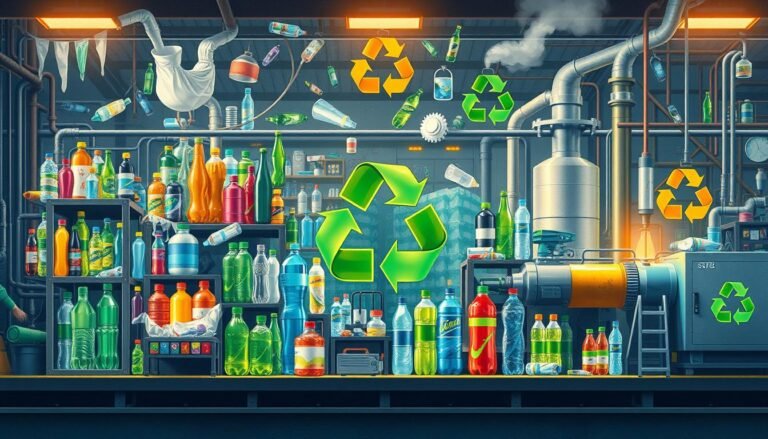Make some changes to the world environment
-
Building 3, Wanyang Innovation City, Langxia Street, Yuyao City, Zhejiang Province
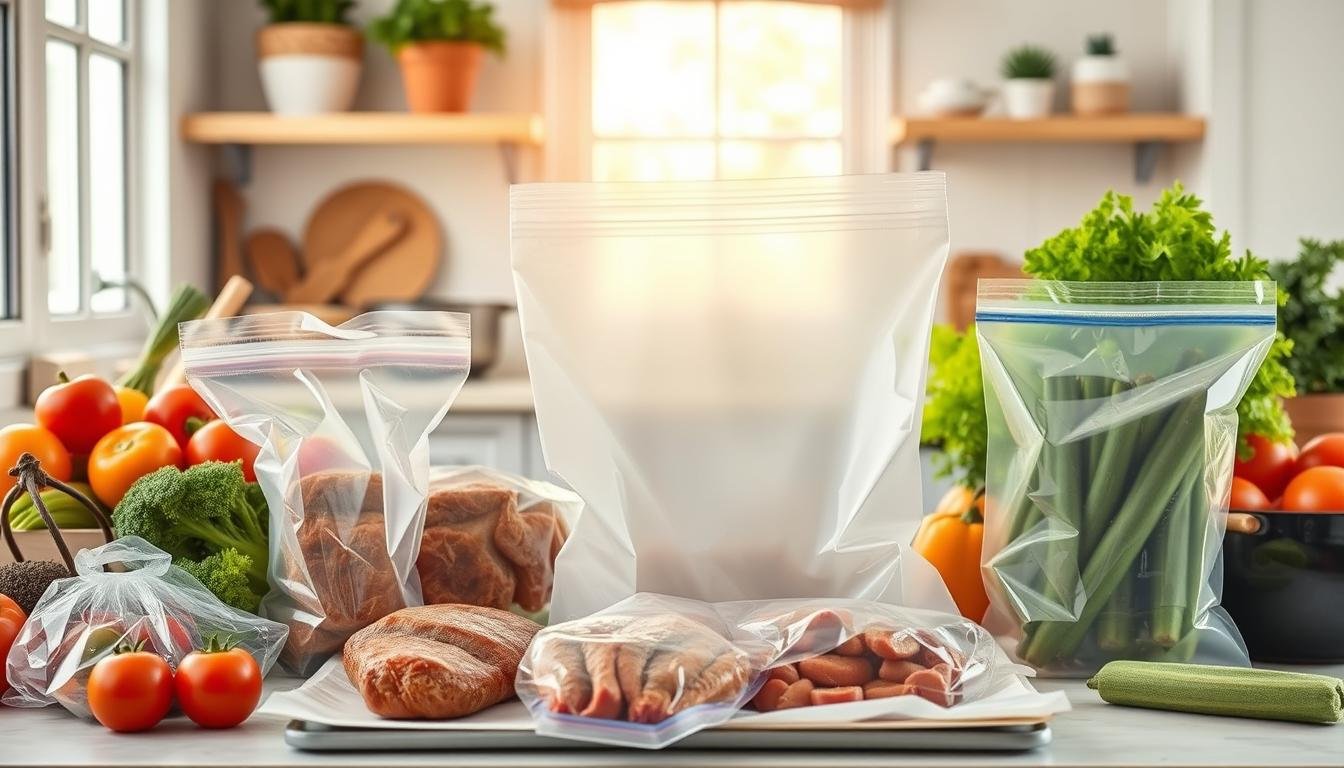
Safe Use of Cooking Plastic Bags in Ovens
Have you ever thought about how safe it is to cook with plastic bags in the oven? These days, more people are using them for easy cooking. But, some folks still worry if they’re safe or not.
Oven bags, like those from Reynolds, are perfect for the high heat of ovens. They make cooking faster by keeping steam in, which cuts down cooking time1. They’re also safe because they’re made of a special heat-proof nylon approved by the FDA1. But, you have to use them right. If not, they could burn, melt, or even burst1.
These cooking bags can take heat up to 392°F (200°C). This means you can use them for lots of recipes2. Some bags even handle hotter temperatures for hours without any damage2. Just remember, they are best used in regular ovens and not for broiling, unless the label says it’s okay1. Also, they don’t let bad chemicals like phthalates and dioxins get into your food2.
Following the right steps, like using a thermometer outside the bag to check meat temperature, helps avoid burns1. Oven bags keep moisture in, but they might not make the outside of foods crispy1. If you want your food crispy, just take it out early and give it some time under the broiler or in the oven without the bag1.
Key Takeaways
- Oven bags speed up cooking by keeping steam inside, which lowers cooking time1.
- Reputable oven bags, like those from Reynolds, meet FDA standards and are made from materials that stand up to heat1.
- These bags can deal with temperatures up to 392°F and some are okay with even more heat for longer2.
- It’s important to use them correctly to avoid problems like burning and letting chemicals into your food1.
- Using thermometers the right way can help you avoid injuries while making sure your food cooks perfectly1.
Understanding Cooking Bags
Cooking bags are essential in today’s kitchens. They offer many benefits and assure safe cooking. These bags are made from materials like nylon or polyester. They can stand temperatures up to 392°F (200°C) safely3. They are perfect for various cooking methods because of their design and versatility.
Types of Cooking Bags
There are different oven bags for all cooking needs:
- Oven Baking Bags: Great for meats and veggies, they handle high heat and cook food evenly.
- Slow Cooker Bags: They line slow cookers for easy cleaning and keep kitchens tidy.
- Microwave Steaming Bags: They’re ideal for quick, healthy steaming of food in the microwave.
Popular brands include Reynolds, PanSaver, and True Liberty Bags, known for their safety and BPA-free materials3. For those looking for an eco-friendly option, Stasher Reusable Silicone Food Bags are safe and sustainable3.
Benefits of Cooking with Bags
Cooking with bags offers more than just convenience:
- Enhanced Flavor and Moisture: They keep moisture in, making dishes like turkey cook faster and stay juicy4.
- Healthier Meals: Bags keep food’s juices, cutting down the need for extra fats and lowering calorie count3.
- Nutrient Preservation: They help keep the nutrients in food, avoiding overcooking and the risk of carcinogens3.
- Easy Cleanup: Slow Cooker and other oven bags reduce cleanup time significantly.
Using bags made from FDA-approved materials means cooking is healthier, without chemical leaching or cross-contamination worries3. For more details on the safety and use of cooking bags, see this resource5.
Health Concerns of Cooking with Plastic Bags
Cooking with plastic bags raises health worries. These worries stem from chemicals like bisphenol A (BPA) moving to food during heating. Especially when food is heated in a microwave, chemicals from the bags can seep into it6. Factors such as how hot it gets, how long it cooks, and the kind of food matter a lot7.
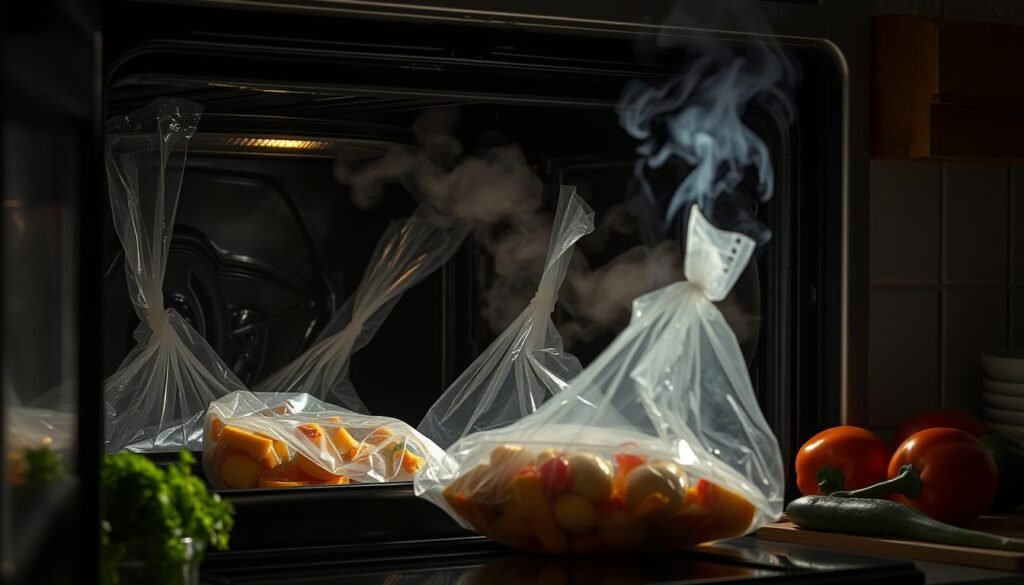
Potential Chemical Migration
Chemicals can move from plastic cooking bags to food, which is a big issue. Phthalates, found in plastics, can mess with our hormones. They become a health risk when they get into food during cooking at high temperatures. There’s also a risk from dioxins, which can get into our food supply, especially in meat and fish, though they come from burning waste, not plastics directly7.
Studies and Research Findings
Research has shown the dangers of cooking in plastic bags. For example, the Utah Department of Health looked into health risks from eating food cooked in these bags6. They found BPA in trout cooked in certain bags, showing chemicals can move to food. Other studies in Europe found harmful substances in food cooked with plastic wraps in microwaves7. This highlights how important it is to use safe cooking bags and follow instructions to stay healthy. The FDA suggests using specific types of plastic for safer cooking options6.
| Chemical | Source | Potential Health Effect |
|---|---|---|
| BPA | Sous Vide Bags | Altered reproductive development, increased cancer risks |
| Phthalates | Plastic Wrapping and Containers | Endocrine disruption, hormone-like behavior |
| Dioxins | Environment via Waste Incineration | Concentrates in meat and fish, can cause health issues |
Understanding these health concerns of cooking with plastic bags helps us choose safer cooking methods and materials.
How Healthy Is Cooking Plastics Bags for Oven
Safe cooking with plastic bags in the oven is possible if you follow the right tips. It’s important to use BPA-free bags that the FDA has okayed. Look for bags from well-known brands like Reynolds and PanSaver, and consider eco-friendly options like Stasher’s platinum silicone bags8.
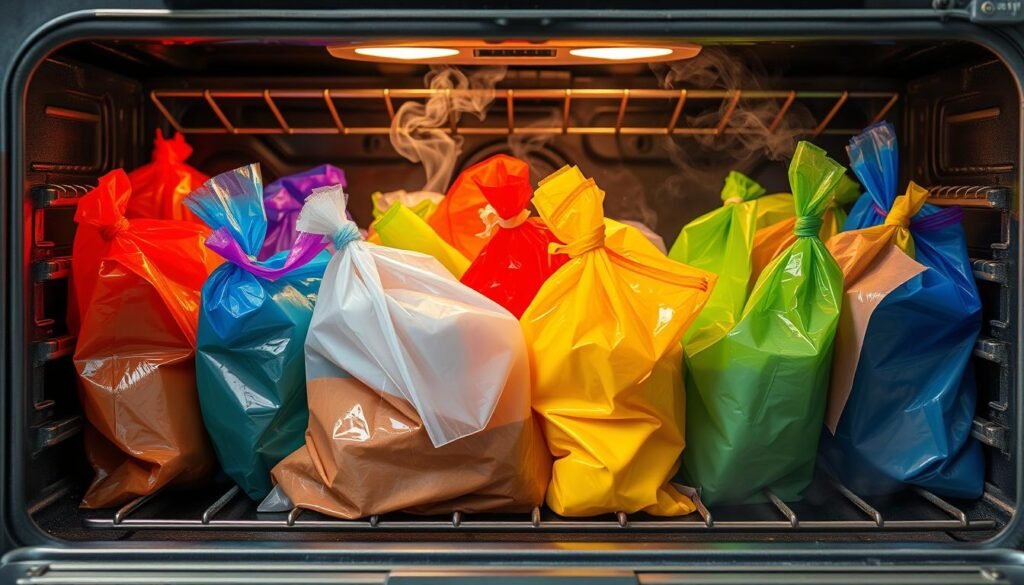
Special oven bags can take heat up to 392°F, and some can even go up to 400°F for hours8. But, keep bags away from direct heat to avoid chemicals getting into your food. Cutting a small hole in the bag lets steam out and helps cook your food evenly8.
Handling and storing cooking bags the right way is key. Don’t reuse bags and use different bags for different foods8. Also, put cooked food in the fridge within two hours to keep it safe and fresh8.
Thinking about the health risks of cooking with oven is important. Chefs argue about the taste difference, but an oven bag can cook a turkey an hour quicker9. Still, choosing top-quality bags and following the cooking guide is crucial.
Proper Handling and Storage of Cooking Bags
It’s important to handle and store cooking bags the right way. This keeps our food safe and these tools working well in the kitchen. We need to store cooking bags safely and keep them away from other foods to avoid mixing.
Avoiding Cross-Contamination
To stop cross-contamination, we must be clean. Always wash your hands before and after touching cooking bags. Always use different bags for raw meats and veggies. This helps stop germs from spreading. Also, don’t reuse cooking bags. It could lead to bacteria in your food, even if you wash them.
Avoiding Risks of Damaged or Expired Bags
Storing cooking bags right keeps them ready for use. Store them away from raw meats and things that could dirty them. Check each bag for rips or holes before you use it. Damaged bags can’t keep your food safe. Also, make sure the bags haven’t expired. Using fresh bags is a key safety step.
Choosing trusted brands like Reynolds means using FDA-approved and BPA-free bags1011. These bags can handle high oven temps. They’re good for many cooking styles10. Always pick bags made for your cooking method, like sous vide bags for precision cooking or crock pot bags for slow cooking11.
Cooking Safety Tips for Plastic Bags in Oven
When cooking with plastic bags, it’s key to pick top brands. Brands like Reynolds, PanSaver, and True Liberty Bags are safe. They are BPA-free and endure up to 400°F12. This step is vital for your safety, especially at high temperatures12.
Don’t overstuff the bags. Overfilled bags might burst, spewing hot steam and possibly causing burns. Leave enough room for steam to move. Make tiny slits in the bag for even heating12. This way, you can stop the bags from bursting accidentally.
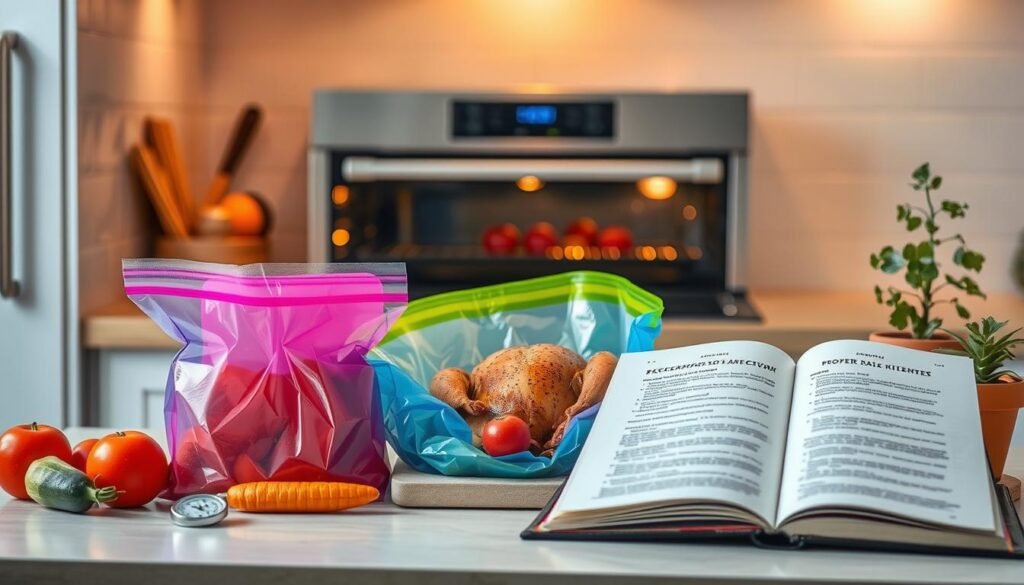
Sealing the bag correctly is also important. Use twist ties, clips, or twine to seal it, to avoid leaks. Leaks can cause cross-contamination and a messy oven12. Also, place the bag in a baking dish, not directly on the rack. This prevents direct heat contact and makes cleanup easier.
Always check your food’s temperature with a thermometer before eating. This confirms that your meal is fully cooked and safe12. Following these steps, like proper sealing and temperature checks, leads to safe and well-cooked dishes.
Remember to refrigerate any cooked food within two hours. This helps to stop bacteria from growing and keeps your food safe12. Using these tips ensures you cook safely with plastic bags and enjoy delicious, worry-free meals.
Risks of Cooking with Plastic Bags
Cooking with plastic bags has some risks we need to know to keep food safe and maintain our health. It’s important to use oven bags at the right temperatures to avoid toxins. Knowing about possible contaminants when cooking can help prevent the release of harmful toxins.
Temperature Guidelines
Some cooking bags made from nylon or polyester can handle up to 392°F (200°C)13. There are also oven bags that can take up to 400°F for hours without breaking13. To prevent issues like the bag bursting, we must follow these temperature rules closely. Also, sealing the bags properly, ventilating, and cooking at the right time and temperature makes using oven bags safer and improves the cooking experience13.
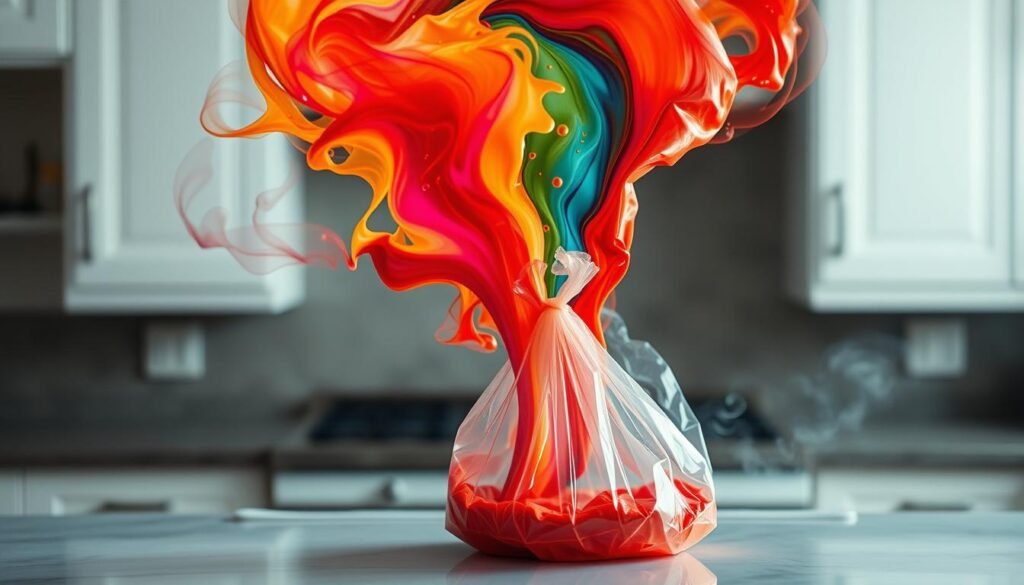
Potential Toxins and Contaminants
There’s worry about toxins released from plastic bags during cooking. Some studies have found that certain plastics, even those claiming to be BPA-free, can release chemicals that affect hormones when heated14. Being exposed to these chemicals a lot can be worse than only once in a while. This shows why it’s key to use FDA-approved materials that are safe13. To cook safely, we should use oven bags made for cooking that don’t risk our health.
Oily foods can make more chemicals move from the bags into the food, raising the risk of eating harmful toxins13. Using damaged or old cooking bags could also let chemicals leak into our food13. It’s important not to reuse bags and to use different bags for different foods to avoid mixing them up13.
Finally, it’s not safe to cook with a single Ziploc bag in water hotter than 158°F because the heat can damage the bag14. But, if we’re careful to follow these tips and choose certified safe brands like Reynolds, PanSaver, and True Liberty Bags, or even try alternatives like Stasher Reusable Silicone Food Bags, we can lessen the dangers of cooking with plastic bags.
Choosing the Right Cooking Bags
Choosing the best oven bags means looking at safety and quality. It’s key to pick brands that are safe to use and consider what they’re made of.
Certified Safe Brands
Brands like Reynolds and PanSaver are known for safe cooking bags without BPA. This means no bad chemicals get into your food. The FDA says to use cooking bags from trusted sources to keep food safe and cook well15. These bags also cook faster, taste better, and make cleaning easier16. Choosing these bags means using less oil, which cuts down calories16.
Material Considerations
The type of plastic is important for oven bags. Nylon and polyester bags handle up to 392°F without melting or harmful leaks15. Polyester can even take up to 400°F for a few hours16. Pick bags that are safe at high heat and free from BPA to keep your food healthy16.
Silicone bags are a green choice and work just as well. They keep moisture in, make food flavorful, and cook faster16. Always check bags for damage to ensure they’re safe for cooking.
Learn more about materials like LDPE by checking out this detailed resource on LDPE pelletizing. It covers the benefits of LDPE in food safety15.
Avoiding Plastic Contamination in Oven Cooking
It’s important to use oven bags safely to avoid plastic contamination when baking or roasting. Following the right directions lets us use cooking bags without harming our health.
Correct Usage and Precautions
Designed for high temperatures, cooking bags are safe up to 400°F if used correctly17. Don’t cook hotter than the bag’s instructions say. Don’t broil or apply direct heat to avoid plastic melting and chemical risks. Choose BPA-free bags to lessen chemical leak risks into food17.
These bags are usually made from nylon or polyester, which are great at dealing with high heat17. Seal them right, make sure they’re ventilated, and follow the time and temperature guide. This helps stop plastic contamination and cooks food well17.
Alternative Options
If you’re worried about plastics, there are other ways to cook. Try silicone bags or go traditional without any bags. Silicone handles heat well without giving off bad stuff. Moving away from black plastic items to glass or metal reduces chemical risks when heated18. Choose metal or bamboo over plastic utensils, and don’t microwave food in plastic containers to cut down on toxin exposure18.
Supporting recycling cuts down on plastic waste. Learning about recycling, like with HDPE plastics, helps the planet. HDPE recycling is good for the environment, saving resources and cutting pollution. Check out our HDPE plastic recycling solutions page for more on eco-friendly practices17.
Cooking Bags and Nutritional Benefits
Using oven bags has great nutritional perks. These bags can handle heat up to 400°F. They keep moisture and nutrients in, making food juicy and rich in vitamins19. This way, food cooks in its own juices, keeping it healthy and full of important minerals19.
Nutritional advantages of oven bags also include less need for extra fat, leading to healthier meals19. These bags help cook food with less fat but still keep it tasty and tender. It’s a smart way to watch your calories without losing out on flavor.
To get the best out of oven bags, stick to the cooking instructions from brands like Reynolds Kitchen Oven Bags and True Liberty Bags. They’re safe for cooking, being BPA-free and meeting FDA rules1920. Using these bags the right way ensures meals cook evenly while keeping nutrients intact19.
Conclusion
Cooking with oven plastic bags has many upsides like cutting down fat in food and keeping different foods from mixing21. It’s vital to pick top-notch, BPA-free brands such as Reynolds Kitchen Oven Bags to avoid chemical leaks21. Also, sticking to the right temperature and making sure bags are opened a bit improves both safety and effectiveness.
Being aware of potential dangers is key too. Some chemicals in plastic bags, like phthalates and dioxins, could harm our health, leading to issues like hormone problems and even cancer2122. It’s crucial to select safe oven bags, for instance, silicone ones that can withstand high heat and are BPA-free2123.
Overall, using oven plastic bags is safe if we follow the right steps. Staying updated on research and knowing how to use these bags properly is essential for health and good cooking results. By choosing and using the right bags, we can enjoy tasty, healthy meals without worrying too much about health risks212322. These insights highlight the need for being informed and careful in cooking practices.


